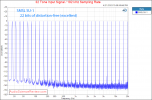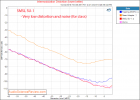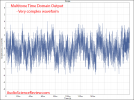TNT
Active Member
- Joined
- Jun 24, 2020
- Messages
- 245
- Likes
- 157
So, what did you do to them?I purchased and am using two SU-1s. Modifications to the SU-1 will be a noticeable upgrade.
SU-1 is very cheap, but don't underestimate it.
//
So, what did you do to them?I purchased and am using two SU-1s. Modifications to the SU-1 will be a noticeable upgrade.
SU-1 is very cheap, but don't underestimate it.
The audibility thresholds of distortion, noise, jitter etc have been well established and the SU-1 is well below all of them.So, in fact, it's the ultimate DAC? No one needs any better?
How do you know this for sure?
(Serious question...)
//
Except that Multitone and SMPTE tests use very complex, "quick turn" waveforms and the SU-1 reconstructs them perfectly as well:OK - I'll accept the Strict Limits - they seem fine. But they are all steady state, i.e. a continuous tone measurements which I think could be a problem. A little like evaluating a car and not do any quick turns...



Do you have any proof that your suggestions are more appropriate to simulate whether music is being reproduced transparently/accurately? Or are you just speculating that the methods used are not good enough?The multitone used here is like wiggling the steering wheel a bit - in addition I would like to see some real brutal turns... i.e. a 3 tone test, say; 40Hz + 1k + 8k. Using 10 or 20 tones, each has too low individual level to my liking... 3 would probably be the most taxing I believe. The SMPTE is a good one - verifies that the basic tech is in place but not so rooted in "music" as levels of these frequencies never occurs naturally.
//
I'm not baiting but i need to ask this please - You claim to hear these differences. What we need to do now rather than talk about it as an opinion, is to find out of these differences really do exist (nulling software should help surely) and also to see the objective measurement changes if they're there.Suppliying a digital signal via USB, which is clocked with a weak clock, and from a good source with a femtosecond clock, what should it influence? Only for jitter. I'm sorry but I can hear it. It's not a "wow" change, but in my opinion it's important. I think it's more noticeable than replacing LME49720 with double OPA627. No, I don't have perfect hearing, I'm 47 years old, but I can hear the differences. Since you're asking this question, have you compared it or are you just writing it this way? Because I listen and hear.
Sorry, but I can hear the jitter. Try to send a signal to some old DAC through the CS8412 or AK4118 receiver. The difference is considerable. Did you hear? I think not. Maybe buy a cheap USB to COAX converter from Aliexpress and see what jitter does to the sound quality.
Mod away and have some fun - but I doubt it'd be sellable afterwards (eighty quid is peanuts to some I suppose so you can chuck it away if it doesn't work out - there is a cheaper slim version that I gather is broadly similar)...OK - I'll accept the Strict Limits - they seem fine. But they are all steady state, i.e. a continuous tone measurements which I think could be a problem. A little like evaluating a car and not do any quick turns...
If you feel contempt with that the presented measurements and stimuli is adequate for completely characterising an amp or DAC - fine. I'm however not totally convinced...
Why - because we can't ignore every observation that indicates an identified difference between devices that both conform to even the strict ones. Most, yes, but perhaps not all... I have a hunch that something will emerge that will move the insight of SQ vs meas correlation one step further.
So for me, I will still keep an eye open for differences even if I, in all general aspects, sympathise with the basic stance of this site.
Now I will go and mod my SU-1 and see if I can detect any improvement... (I have two) it will be adding some caps for cleaner power to OPamp and clocks, bypassing the output switch (about 5-15 dB worse than the Strict Limits) and some mechanical damping of the clocks.
//
Proof... not that will stand up in court. But, it is more of a reasoning (speculation if you will...) from my side over the subject, taking my experiance and knowledge into the mix. Either you don't "think" I have a case or you know for a fact that I don't or, you might think that the reasoning is not completely insane...Do you have any proof that your suggestions are more appropriate to simulate whether music is being reproduced transparently/accurately? Or are you just speculating that the methods used are not good enough?
I wouldn't say I have extensive knowledge on the subject of measuring DACs, so I can't confidently say whether your reasoning is insane or not. Everyone is entitled to speculate, and to have their own opinion. That's what forums are for. However, if your arguments come from personal experience, they should not be presented as factual.Proof... not that will stand up in court. But, it is more of a reasoning (speculation if you will...) from my side over the subject, taking my experiance and knowledge into the mix. Either you don't "think" I have a case or you know for a fact that I don't or, you might think that the reasoning is not completely insane...
//
Mine has the Rubycons already on board...? And better soldered, to be honest. As far as I remember, one Opamp was "treated" by SMSL in my DAC so you can't read the the designation. See image: https://www.audiosciencereview.com/forum/index.php?attachments/rubycon-jpg.310508/I will not answer this question which gives a greater effect. I made changes one by one. Finally, I changed the source between USB and Gustard u18. For every change there is improvement. How big? It is known that in audio everything is subjectiveThe cheapest thing is to change the capacitors, then the operational amplifiers and finally the digital signal source. So in my opinion this is the best order
How do you "treat" an op-amp?Mine has the Rubycons already on board...? And better soldered, to be honest. As far as I remember, one Opamp was "treated" by SMSL in my DAC so you can't read the the designation. See image: https://www.audiosciencereview.com/forum/index.php?attachments/rubycon-jpg.310508/
The mentioned operational amplifier is LME49720, i.e. double and is responsible for sound output. The capacitors you have are the PX series, cheaper and worse than ZLH. I soldered mine myself and since they are larger, they had to be soldered this way. If you play with an open DAC and look at it, it is better not to change anything in it, because you will spoil the aesthetic effect.Mine has the Rubycons already on board...? And better soldered, to be honest. As far as I remember, one Opamp was "treated" by SMSL in my DAC so you can't read the the designation. See image: https://www.audiosciencereview.com/forum/index.php?attachments/rubycon-jpg.310508/
It doesn't make any difference; MQA is a well perpetrated lossless scam, so the farther away you get from it, the better it is for you.Connected DAC to WiiM mini. To get full unfold of MQA I have to set DAC to renderer only. Magenta led turns on in this case. But WiiM is limited to 96kHz max in this case. I suppose that DAC is not MQA decoder in order to get higher resolution. It seems that it is just renderer. Correct?
I meant: don't bother, you gain nothing.I'm well aware about MQA situation. However, not the answer I was looking for. Thanks for the effort.
